
Lecture on Electronic Structure with a powerpoint presentation and corresponding lecture slide notes.

Lecture on Electronic Structure with a powerpoint presentation and corresponding lecture slide notes.
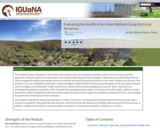
This module introduces students to the fundamental principles and uses of electrical resistivity, with a focus on an environmental application. Students explore the characteristics and environmental setting of Harrier Meadow, a saltmarsh just outside of New York City. They investigate the relationship between electrical resistivity and physical properties of the soil in the marsh. Students also discover how variations in survey configuration parameters control investigation depth (how far into the ground the signals sense) and spatial resolution (what size objects can be detected). Finally, students learn about and then perform geophysical inversion, which is the process of estimating the geophysical properties of the subsurface from geophysical observations. In the final unit of the module, students evaluate the extent to which the geophysical dataset and direct physical measurements support the hypothesis, introduced in Unit 1, accounting for the distribution of Pickleweed in Harrier Meadow.
This module is intended to require approximately 2-3 weeks of class time. Teaching material includes PowerPoints that may be used in lectures or provided for self-guided learning, exercises, and handouts that ask students to synthesize what they learn from the exercises. In addition, multiple choice and short answer questions can be given to students as homework, on quizzes, or on exams.
(Note: this resource was added to OER Commons as part of a batch upload of over 2,200 records. If you notice an issue with the quality of the metadata, please let us know by using the 'report' button and we will flag it for consideration.)
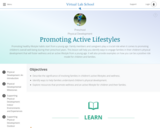
Promoting healthy lifestyle habits starts from a young age. Family members and professionals can assume significant roles when it comes to promoting children’s overall well-being during preschool years. This lesson will help you identify ways to engage families in their children’s physical development that will foster wellness and an active lifestyle from a young age. It will also demonstrate how you can be a positive role model for children and families.

This class develops the abilities of students to communicate science effectively in a variety of real-world contexts. It covers strategies for dealing with complex areas like theoretical physics, genomics and neuroscience, and addresses challenges in communicating about topics such as climate change and evolution. Projects focus on speaking and writing, being an expert witness, preparing briefings for policy-makers, writing blogs, and giving live interviews for broadcast, as well as the creation of an interactive exhibit for display in the MIT Museum.

Welcome to Child Growth and Development. This text is a presentation of how and why children grow, develop, and learn. We will look at how we change physically over time from conception through adolescence. We examine cognitive change, or how our ability to think and remember changes over the first 20 years or so of life. And we will look at how our emotions, psychological state, and social relationships change throughout childhood and adolescence.
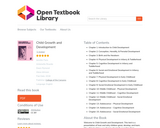
Welcome to Child Growth and Development. This text is a presentation of how and why children grow, develop, and learn. We will look at how we change physically over time from conception through adolescence. We examine cognitive change, or how our ability to think and remember changes over the first 20 years or so of life. And we will look at how our emotions, psychological state, and social relationships change throughout childhood and adolescence.

This course presents fundamental principles and methods of materials and structures for aerospace engineering, and engineering analysis and design concepts applied to aerospace systems. The topics include statics; analysis of trusses; analysis of statically determinate and indeterminate systems; stress-strain behavior of materials; analysis of beam bending, buckling, and torsion; and material and structural failure, including plasticity, fracture, fatigue, and their physical causes. Experiential lab and aerospace system projects provide additional aerospace context.

This course examines the dynamic interrelations among physical and behavioral traits of humans, environment, and culture to provide an integrated framework for studying human biological evolution and modern diversity. Topics include issues in morphological evolution and adaptation; fossil and cultural evidence for human evolution from earliest times through the Pleistocene; evolution of tool use and social behavior; modern human variation and concepts of race. The class also studies stone artifacts and fossil specimens.

This course teaches simple reasoning techniques for complex phenomena: divide and conquer, dimensional analysis, extreme cases, continuity, scaling, successive approximation, balancing, cheap calculus, and symmetry. Applications are drawn from the physical and biological sciences, mathematics, and engineering. Examples include bird and machine flight, neuron biophysics, weather, prime numbers, and animal locomotion. Emphasis is on low-cost experiments to test ideas and on fostering curiosity about phenomena in the world.
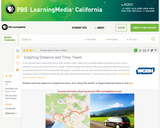
In this lesson designed to enhance literacy skills, students learn how to read and interpret a distance–time graph.

This video is a segment from the Switch Energy Project focusing on energy security. Switch Energy Project is a multi-pronged effort designed to build a balanced national understanding of energy.
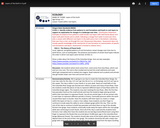
In this lesson students will learn about rock formations and fossils within rock layers. Includes video links, discussion, and activity instructions.
NGSS: 4-ESS1-1
Time: 1 hour
Materials: bucket of clay and plastic animals
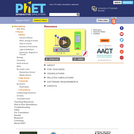
For advanced undergraduate students: Observe resonance in a collection of driven, damped harmonic oscillators. Vary the driving frequency and amplitude, the damping constant, and the mass and spring constant of each resonator. Notice the long-lived transients when damping is small, and observe the phase change for resonators above and below resonance.
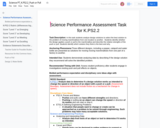
This performance assessment aligns with NGSS Performance Expectation K.PS2.2 and is intended to be used as an interim assessment. These assessments can either be used summatively, as an end of learning activity, or formatively, utilizing student responses to identify next instructional steps.
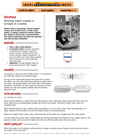
In this activity, learners create a tornado in a bottle to observe a spiraling, funnel-shaped vortex. A simple connector device allows water to drain from a 2-liter bottle into a second bottle. Learners can observe the whirling water and then repeat the process by inverting the bottle. Use this activity to talk about surface tension, pressure, gravity, friction, angular momentum, and centripetal force.
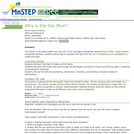
This hands on lab helps explain why the color of our sky/upper atmosphere appears blue in color. Students will be able to simulate how light from the sun is scattered by our atmosphere to create blue light.

Students use gesture to convey information about mineral cleavage and the relationship between crystal structures and cleavage planes.
(Note: this resource was added to OER Commons as part of a batch upload of over 2,200 records. If you notice an issue with the quality of the metadata, please let us know by using the 'report' button and we will flag it for consideration.)

This ebook contains background information, video tutorials and virtual exercises for the Biochemistry Laboratory module. Gas chromatography (GC) and mass spectrometry (MS) are analysis methods that require a lot of background information and intense theory. This interactive ebook will help you understand the information behind these analysis methods, and is accessible through iTunes.
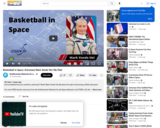
Ever wondered how you could be a astronaut? Watch Mark Vande Hei talk about his path to becoming a NASA astronaut!

Students explore augmented reality audio through the design and evaluation of prototypes. Participants will probe design space and illuminate creative possibilities. This includes productive, playful, and social applications, as well as the intersection between games and music. The course builds understanding of the limitations and strengths of iterative design and rapid prototyping as research methods, familiarizes students with the theoretical foundations of design exploration, and practices working with physical and digital materials.